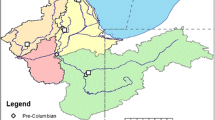Abstract
As part of NOAA's National Status and Trends Mussel Watch Program, oysters were sampled along the Gulf of Mexico coast each winter from 1986 to 1993 (The present analysis deals with 1986–1993 Mussel Watch data; the Mussel Watch project itself continues at this printing) and analyzed for trace metal, polynuclear aromatic hydrocarbons and pesticide body burden, plus a series of biological variables designed to assess population status and health. We identified contaminant and biological variables in which large-scale spatial processes played an important role in establishing population values by examining the likelihood that neighboring bays tended to have populations with body burdens or population attributes more similar than expected by chance.
Local or watershed-dependent factors, such as land use and freshwater inflow, are important in controlling the bay-to-bay variation in body burden in most contaminants. However, the bay-to-bay variations in body burden of some metals (As, Cd, Hg, Ni, Se) appear to be principally influenced by larger-scale climatic factors. These metals and the biological variable shell length demonstrated a strong degree of similarity between bays over a large regional area reminiscent of the pattern shown by climatic factors, such as temperature and precipitation. In contrast, among the organics, none of the PAHs showed even a moderately strong climatic signal. Among the pesticides, only two did (dieldrin, total DDTs). These pesticides and the biological variables, reproductive stage and Perkinsus marinus prevalence and infection intensity, had spatial patterns that suggested both a local and a regional influence to their geographic distributions. This same pattern is exhibited by freshwater runoff. Metal contaminants also behaved distinctively compared to organics in the temporal influence of climate in establishing the interannual variability in body burden. For the organics, trends in interannual variability were strongly influenced by climate, whereas spatial trends were not. In contrast, most metals were unaffected by climatic forcing both spatially and temporally. However, all of the metals having a spatial pattern strongly influenced by climate (As, Cd, Hg, Ni, Se) also exhibited interannual variations related to variations in climate.
Similar content being viewed by others
Author information
Authors and Affiliations
Additional information
Received: 14 October 2000/Accepted: 9 January 2001
Rights and permissions
About this article
Cite this article
Kim, Y., Powell, E., Wade, T. et al. The Geographic Distribution of Population Health and Contaminant Body Burden in Gulf of Mexico Oysters. Arch. Environ. Contam. Toxicol. 41, 30–46 (2001). https://doi.org/10.1007/s002440010218
Issue Date:
DOI: https://doi.org/10.1007/s002440010218




